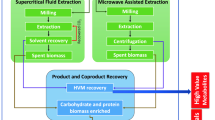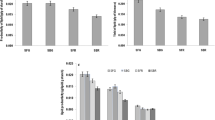Abstract
Starch-enriched brewery waste (SBW), an unexplored feedstock, was investigated as a nutritious low-cost source for the mixotrophic cultivation of Ettlia sp. YC001 for biodiesel production. Stirring, autoclaving, and sonication were assessed for the SBW, in conjunction with pH. Stirring at 55 °C was found to be the best, in terms of the effectiveness of starch hydrolysis and yeast disintegration as well as cost. The treated solutions were found to support the mixotrophic growth of microalgae: 20 g/L of glucose medium resulted in the highest biomass production of 9.26 g/L and one with 10 g/L of glucose showed the best lipid productivity of 244.2 mg/L/day. The unsaturated fatty acids increased in the resulting lipid and thus quality well suited for the transportation fuel. All these suggested that SBW, when treated properly, could indeed serve as a cheap feedstock for microalgae-based biodiesel production.




Similar content being viewed by others
References
Alexandre, H., & Guilloux-benatier, M. (2006). Yeast autolysis in sparkling wine—a review. Australian Journal of Grape and Wine Research, 12, 119–127.
Babayan, T. L., Bezrukov, M. G., Latov, K. V., Belikov, V. M., Belatseva, E., & Titova, E. F. (1981). Induced autolysis of Saccharomyces cerevisiae: morphological effects, rheological effects and dynamics of accumulation of extracellular hydrolysis products. Current Microbiology, 5, 163–168.
Cheirsilp, B., & Torpee, S. (2012). Enhanced growth and lipid production of microalgae under mixotrophic culture condition: effect of light intensity, glucose concentration and fed-batch cultivation. Bioresource Technology, 110, 510–516.
Choi, J. A., Kim, D. Y., Seo, Y. H., & Han, J. I. (2016). Application of Fe (NO 3) 3-based as nitrogen source and coagulant for cultivation and harvesting of Chlorella sorokiniana. Bioresource Technology, 222, 374–379.
Chung, J., Lee, I., & Han, J. I. (2016). Biodiesel production from oleaginous yeasts using livestock wastewater as nutrient source after phosphate struvite recovery. Fuel, 186, 305–310.
Duarte, J. H., Fanka, L. S., & Costa, J. A. V. (2016). Utilization of simulated flue gas containing CO 2, SO 2, NO and ash for Chlorella fusca cultivation. Bioresource Technology, 214, 159–165.
Farooq, W., Lee, Y. C., Ryu, B. G., Kim, B. H., Kim, H. S., Choi, Y. E., & Yang, J. W. (2013). Two-stage cultivation of two Chlorella sp. strains by simultaneous treatment of brewery wastewater and maximizing lipid productivity. Bioresource Technology, 132, 230–238.
Geciova, J., Bury, D., & Jelen, P. (2002). Methods for disruption of microbial cells for potential use in the dairy industry—a review. International Dairy Journal, 12, 541–553.
Huang, C., Chen, X. F., **ong, L., Ma, L. L., & Chen, Y. (2013). Single cell oil production from low-cost substrates: the possibility and potential of its industrialization. Biotechnology Advances, 31(2), 129–139.
Isleten-Hosoglu, M., Ayyildiz-Tamis, D., Zengin, G., & Elibol, M. (2013). Enhanced growth and lipid accumulation by a new Ettlia texensis isolate under optimized photoheterotrophic condition. Bioresource Technology, 131, 258–265.
Kim, M., Shin, W., & Sohn, H. (2015). Application of the lees of domestic traditional wine and its useful biological activity. Journal of Life Sciences, 25, 1072–1079.
Lee, H. S., Hong, K. H., Kim, J. Y., Kim, D. H., Yoon, C. H., & Kim, S. M. (2009). Blood pressure lowering effect of Korean turbid rice wine (Takju) lees extracts in spontaneously hypertensive rat (SHR). Journal of the Korean Society of Food Culture, 24(3), 338–343.
Li, Y. R., Tsai, W. T., Hsu, Y. C., **e, M. Z., & Chen, J. J. (2014). Comparison of autotrophic and mixotrophic cultivation of green microalgal for biodiesel production. Energy Procedia, 52, 371–376.
Liang, Y., Sarkany, N., & Cui, Y. (2009). Biomass and lipid productivities of Chlorella vulgaris under autotrophic, heterotrophic and mixotrophic growth conditions. Biotechnology Letters, 31, 1043–1049.
Perez-Garcia, O., Escalante, F. M., de-Bashan, L. E., & Bashan, Y. (2011). Heterotrophic cultures of microalgae: metabolism and potential products. Water Research, 45(1), 11–36.
Ramos, M. J., Fernández, C. M., Casas, A., Rodríguez, L., & Pérez, Á. (2009). Influence of fatty acid composition of raw materials on biodiesel properties. Bioresource Technology, 100, 261–268.
Ratledge, C. (1991). Microorganisms for lipids. Engineering in Life Sciences, 11(5), 429–438.
Ryu, B. G., Kim, J., Kim, K., Choi, Y. E., Han, J. I., & Yang, J. W. (2013). High-cell-density cultivation of oleaginous yeast Cryptococcus curvatus for biodiesel production using organic waste from the brewery industry. Bioresource Technology, 135, 357–364.
Schneider, T., Graeff-Hönninger, S., French, W. T., Hernandez, R., Merkt, N., Claupein, W., Hetrick, M., & Pham, P. (2013). Lipid and carotenoid production by oleaginous red yeast Rhodotorula glutinis cultivated on brewery effluents. Energy, 61, 34–43.
Seo, G. U., Choi, S. Y., Kim, T. W., Ryu, S. G., Park, J. H., & Lee, S. C. (2013). Functional activities of Makgeolli by-products as cosmetic materials. Journal of the Korean Society of Food Science and Nutrition, 42(4), 505–511.
Seo, Y. H., Lee, I., Jeon, S. H., & Han, J.-I. (2014). Efficient conversion from cheese whey to lipid using Cryptococcus curvatus. Biochemical Engineering Journal, 90, 149–153.
Šoštarič, M., Klinar, D., Bricelj, M., Golob, J., Berovič, M., & Likozar, B. (2012). Growth, lipid extraction and thermal degradation of the microalga Chlorella vulgaris. New Biotechnology, 29(3), 325–331.
Stansell, G. R., Gray, V. M., & Sym, S. D. (2012). Microalgal fatty acid composition: implications for biodiesel quality. Journal of Applied Phycology, 24, 791–801.
Sung, M., Seo, Y. H., Han, S., & Han, J. I. (2014). Biodiesel production from yeast Cryptococcus sp. using Jerusalem artichoke. Bioresource Technology, 155, 77–83.
Tanguler, H., & Erten, H. (2008). Utilisation of spent brewer’s yeast for yeast extract production by autolysis: the effect of temperature. Food and Bioproducts Processing, 86, 317–321.
Waters, D. L. E., Henry, R. J., Reinke, R. F., & Fitzgerald, M. A. (2006). Gelatinization temperature of rice explained by polymorphisms in starch synthase. Plant Biotechnology Journal, 4, 115–122.
Wei, A., Zhang, X., Wei, D., Chen, G., Wu, Q., & Yang, S.-T. (2009). Effects of cassava starch hydrolysate on cell growth and lipid accumulation of the heterotrophic microalgae Chlorella protothecoides. Journal of Industrial Microbiology & Biotechnology, 36, 1383.
Xue, F., Gao, B., Zhu, Y., Zhang, X., Feng, W., & Tan, T. (2010). Pilot-scale production of microbial lipid using starch wastewater as raw material. Bioresource Technology, 101, 6092–6095.
Acknowledgements
This work is financially supported by Grant KK-1605 from the Korea Institute of Toxicology. This work is also financially supported by Korea Minister of Ministry of Land, Infrastructure and Transport (MOLIT) as U-City Masters and Doctor Course Grant Program.
Author information
Authors and Affiliations
Corresponding author
Rights and permissions
About this article
Cite this article
Kam, Y., Sung, M., Cho, H. et al. Utilization of Starch-Enriched Brewery (Rice Wine) Waste for Mixotrophic Cultivation of Ettlia Sp. YC001 Used in Biodiesel Production. Appl Biochem Biotechnol 183, 1478–1487 (2017). https://doi.org/10.1007/s12010-017-2515-3
Received:
Accepted:
Published:
Issue Date:
DOI: https://doi.org/10.1007/s12010-017-2515-3




